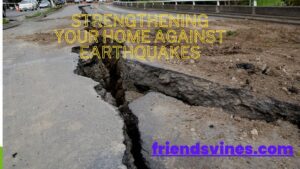Strengthening Your Home Against Earthquakes
Learn how to strengthen your home against earthquakes and protect your family and property. Get expert advice on safety during seismic events.
Introduction:
Living in an earthquake-prone region can be both beautiful and daunting. While natural disasters are beyond our control, there are proactive steps you can take to strengthen your home against earthquakes. By implementing the right techniques and using appropriate materials, you can significantly reduce the risk of damage and protect your haven. In this comprehensive guide, we will explore various methods to fortify your home, from foundation to roof, and provide you with expert insights on earthquake-proof construction.
Strengthening Your Home Against Earthquakes:
An earthquake can cause severe structural damage to your home, compromising its integrity and putting your family at risk. By proactively taking steps to strengthen your home, you can minimize potential damage and ensure your loved ones’ safety. Let’s delve into the various aspects of earthquake-proofing your home.
Understanding Earthquakes and Their Impact:
Before diving into the measures for strengthening your home, it’s crucial to understand earthquakes and how they affect structures. Earthquakes are caused by the sudden release of energy in the Earth’s crust, resulting in seismic waves. These waves can lead to ground shaking, surface rupture, and ground displacement, posing a threat to buildings and infrastructure.
Conducting a Seismic Risk Assessment:
The first step in earthquake-proofing your home is to assess its vulnerability to seismic activity. A seismic risk assessment will help you identify potential weaknesses and prioritize necessary upgrades. Consulting with a structural engineer can provide valuable insights and recommendations tailored to your specific home.
Reinforcing the Foundation:
The foundation is the backbone of any structure, and reinforcing it is paramount for earthquake resilience. Implementing techniques like adding shear walls, installing foundation anchor bolts, and using reinforced concrete can significantly enhance your home’s ability to withstand seismic forces.
Securing Non-structural Elements:
During an earthquake, non-structural elements like furniture, appliances, and decorations can become hazardous if not secured properly. Learn how to anchor heavy furniture, fasten shelves, and secure appliances to prevent them from toppling during seismic events.
Upgrading Exterior Walls and Roof:
Weak exterior walls and roofs are susceptible to collapse during earthquakes. Strengthening these components with bracing, retrofitting, and using flexible roofing materials can reduce the risk of damage and protect your family from harm.
The Role of Building Shape and Design:
The shape and design of your home can significantly influence its earthquake resistance. Certain shapes, such as rectangular or square, perform better during seismic events than irregular ones. Learn about the best architectural practices to improve your home’s earthquake resistance.
Using Seismic-Resistant Materials:
Utilizing seismic-resistant materials can make a substantial difference in protecting your home. Explore the use of flexible materials, cross-laminated timber, and reinforced masonry to enhance your home’s earthquake resilience.
Importance of Seismic Retrofitting:
If you own an older home, it might not have been built with modern seismic safety standards. Seismic retrofitting is a process that involves upgrading older structures to meet current earthquake-resistant guidelines. Discover the significance of seismic retrofitting and its benefits for your home.
Considering Soil and Site Conditions:
The type of soil and the site’s geological conditions can affect how your home responds to seismic forces. Understanding the local soil and site characteristics is crucial in making informed decisions during construction or retrofitting.
Incorporating Damping Systems:
Damping systems can dissipate earthquake energy and reduce structural motion. Learn about different damping technologies, such as tuned mass dampers and viscous dampers, and their application in earthquake-resistant construction.
Preparing an Emergency Earthquake Kit:
Despite the best preparations, earthquakes can still catch us off guard. Assemble an emergency earthquake kit with essential supplies like food, water, first aid items, and important documents to ensure your family’s safety during the aftermath of a quake.
Engaging the Community:
Strengthening your home against earthquakes is just one piece of the puzzle. Engaging with your community and participating in earthquake preparedness initiatives can foster a safer neighborhood and enhance overall resilience.
Raising Awareness Among Family Members:
Educating your family members about earthquake safety is vital. Conduct drills, discuss evacuation plans, and teach everyone how to respond during an earthquake to minimize panic and ensure a coordinated response.
Benefits of Retrofitting Insurance:
Retrofitting your home for earthquake resistance might make you eligible for special insurance benefits. Check with your insurance provider to understand the potential cost savings and added protection that come with a retrofitted home.
Collaborating with Professionals:
Earthquake-proofing your home is a complex task that requires expertise and experience. Collaborate with licensed contractors and engineers who specialize in seismic retrofitting to ensure the highest quality of work.
Common Myths About Earthquake-Proofing:
Separate fact from fiction by debunking common myths surrounding earthquake-proofing techniques. Understanding the truth can guide you toward making well-informed decisions about protecting your home.
Government Regulations and Building Codes:
Stay updated on local government regulations and building codes related to earthquake-resistant construction. Compliance with these guidelines is essential in ensuring the safety and legality of your home improvements.
Ensuring Continuous Maintenance:
Maintaining your home’s earthquake-resistant features is crucial for long-term efficacy. Regular inspections, repairs, and upgrades will help sustain the integrity of your home’s earthquake-proofing measures.
Seismic Retrofitting for Heritage Buildings:
Heritage buildings hold cultural and historical significance, and preserving them in earthquake-prone regions requires unique strategies. Learn about seismic retrofitting approaches tailored to heritage structures.
Earthquake Safety for Multi-Story Buildings:
Living in a multi-story building adds complexity to earthquake preparedness. Discover specialized measures for safeguarding multi-story residential and commercial properties.
Evaluating the Cost-Benefit Ratio:
Earthquake-proofing your home involves an investment. Evaluate the cost-benefit ratio of various upgrades to ensure you make well-balanced decisions that prioritize safety and financial feasibility.
Landscape Considerations for Earthquake-Prone Regions:
Your landscape design can also play a role in earthquake resilience. Learn how to make your garden and outdoor spaces safer during seismic events.
Earthquake Early Warning Systems:
Earthquake early warning systems can provide crucial seconds to minutes of advance notice before shaking begins. Familiarize yourself with available warning systems and their effectiveness.
Others:
Strengthening your home against earthquakes is an investment in the safety and well-being of your family. By understanding the principles of earthquake-resistant construction and implementing effective strategies, you can create a secure environment for your loved ones. Remember to engage with professionals, stay informed about local regulations, and continuously maintain your home’s earthquake-proofing measures. With these measures in place, you can face the uncertainty of earthquakes with confidence and protect your haven.
FAQs
Q: What is the first step in earthquake-proofing my home?
A: Conduct a seismic risk assessment to identify vulnerabilities and prioritize necessary upgrades.
Q: Can seismic retrofitting make my home eligible for insurance benefits?
A: Yes, retrofitting your home might make you eligible for special insurance benefits, providing added protection and cost savings.
Q: How can I secure non-structural elements in my home?
A: You can anchor heavy furniture, fasten shelves, and secure appliances to prevent them from toppling during earthquakes.
Q Do older homes require seismic retrofitting?
A: Yes, older homes may not meet modern seismic safety standards, making seismic retrofitting essential for their protection.
Q: What are damping systems, and how do they help earthquake-proof my home?
A: Damping systems dissipate earthquake energy, reducing structural motion and enhancing earthquake resistance.
Q: How can I engage my community in earthquake preparedness?
A: Participate in earthquake preparedness initiatives and work with neighbors to foster a safer neighborhood.

[…] Explore the conservation efforts dedicated to protecting sharks from the threat of extinction. Gain insights into the challenges faced by these incredible creatures and how you can contribute to their preservation. […]
[…] Protect Your Family‘s Adventures with Insurance: […]